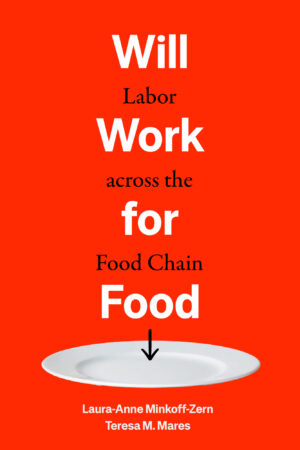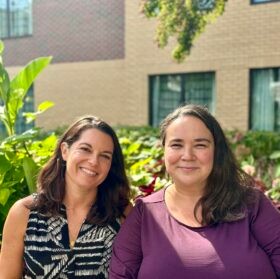How Immigrant Workers Hold Up the Food System
By Laura-Anne Minkoff-Zern and Teresa Mares, authors of Will Work for Food: Labor Across the Food Chain
As our book Will Work for Food publishes, we face a daily onslaught of news headlines reporting on ICE agents stalking and detaining immigrant food workers in our own communities and across the nation. This time of fear and intimidation feels like a far cry from where the public discussion regarding food and farm workers was only five years ago.
We started writing this book during the COVID-19 pandemic, when there was a growing public awakening to the daily labor of people on farms, in processing facilities, and school cafeterias. As many of us experienced the privilege of working from home, those deemed essential–especially the essential workers bringing food to our plates—appeared regularly across media and public policy. There was “hero pay” for grocery workers, people sewing masks for farmworkers (often because they were not being prioritized for state-provided PPE), and food sector unions celebrated a series of campaign wins in Starbucks cafes and Amazon warehouses. This seemed like a moment of hope for food workers. Consumers were finally recognizing the diverse and multifaceted chains of laborers behind their boneless skinless chicken breasts and containers of Thai food picked up curbside.

In Will Work for Food, we trace the long history of labor organizing in all sectors of the food system, from farm work to trucking and labor in the home to the food waste stream. We draw upon stories of food labor organizers such as the United Farmworkers, who campaigned for better wages and treatment in the California fields, to lesser-known groups, such as women organizing within the “Wages for Housework” movement for the underappreciated domestic labor performed to feed families globally.
Yet under the current presidential administration, The Food Chain Workers Alliance (FCWA) and other food worker organizing groups supporting immigrant communities have redirected their energy from proactively advocating for better working conditions to a place of defense. Most of their organizing efforts now focus on supporting detained workers and mobilizing allies to protect workers against ICE raids on worksites. While not all food workers in the US are immigrants, policy experts estimate that at least two million immigrant workers labor in the food system. Over the past several months many have experienced unrelenting attacks on their safety and livelihoods, as their communities and workplaces have been targeted by immigration enforcement.
There is a limit to workers' willingness to absorb this fear and danger. Many of the sending communities that farms and food processing factories have actively recruited from for decades are reluctant to migrate north. The risks now outweigh the benefits of coming to the United States. Those already living in the US fear leaving their homes, purchasing their own groceries, and showing up to work. Farmers are struggling with unharvested fields as undocumented immigrants from Mexico and Central America stay home. Managers in meat processing facilities and food shipping warehouses are seeing Haitian refugees, who have become a core part of the food chain workforce and recently lost their protected status, fail to fill spots on the line.
There is no quality food for consumers if workers are not treated with dignity and justice. It is only in this world that we will have a food system that is truly healthy and safe for all.
—Laura-Anne Minkoff-Zern and Teresa Mares
Just as labor organizers said during the pandemic, the goal is not to return to the status quo. Food and farm labor organizers—from national groups like the FCWA to locally-based worker centers like Vencenermos in Arkansas and Community to Community in Washington state—still aspire to a better world for food workers. They hope to live in a world where picking tomatoes and composting our food waste is recognized as valued labor, and rewarded with higher wages, fair conditions, inclusive benefits, and reasonable time off. Workers should be able to feed their own families as well as they feed the general public.
As we write in the book, many food workers do find meaning in their jobs, knowing that their labor provides sustenance and enjoyment for consumers. But no one enjoys not being able to afford rent or having to contend with unpredictable shifts and schedules. And certainly no one wants to deal with heat stroke in the field or kitchen or lack of proper restroom facilities or breaks to use them on the job.
In making an argument for a chain approach to understanding food systems labor, we hope we provide context for addressing this distressing moment, and also remind readers that the organizers and activists advocating for food workers and immigrants have been here all along. If you are asking yourself what you can do to protect the immigrant communities that work to feed you, look no further than the unions and worker centers in your communities. Show up to a training, ask them what they need, and be there to ensure their health and safety.
We want to see a world where farm and food workers are not on the defensive, but are working towards building thriving and healthy lives. There is no quality food for consumers if workers are not treated with dignity and justice. It is only in this world that we will have a food system that is truly healthy and safe for all.
